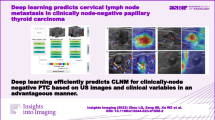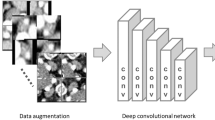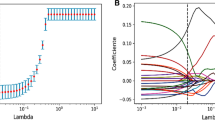Abstract
Objectives
To develop an artificial intelligence (AI) system for predicting cervical lymph node metastasis (CLNM) preoperatively in patients with papillary thyroid cancer (PTC) based on CT images.
Methods
This multicenter retrospective study included the preoperative CT of PTC patients who were divided into the development, internal, and external test sets. The region of interest of the primary tumor was outlined manually on the CT images by a radiologist who has eight years of experience. With the use of the CT images and lesions masks, the deep learning (DL) signature was developed by the DenseNet combined with convolutional block attention module. One-way analysis of variance and least absolute shrinkage and selection operator were used to select features, and a support vector machine was used to construct the radiomics signature. Random forest was used to combine the DL, radiomics, and clinical signature to perform the final prediction. The receiver operating characteristic curve, sensitivity, specificity, and accuracy were used by two radiologists (R1 and R2) to evaluate and compare the AI system.
Results
For the internal and external test set, the AI system achieved excellent performance with AUCs of 0.84 and 0.81, higher than the DL (p = .03, .82), radiomics (p < .001, .04), and clinical model (p < .001, .006). With the aid of the AI system, the specificities of radiologists were improved by 9% and 15% for R1 and 13% and 9% for R2, respectively.
Conclusions
The AI system can help predict CLNM in patients with PTC, and the radiologists’ performance improved with AI assistance.
Clinical relevance statement
This study developed an AI system for preoperative prediction of CLNM in PTC patients based on CT images, and the radiologists’ performance improved with AI assistance, which could improve the effectiveness of individual clinical decision-making.
Key Points
• This multicenter retrospective study showed that the preoperative CT image-based AI system has the potential for predicting the CLNM of PTC.
• The AI system was superior to the radiomics and clinical model in predicting the CLNM of PTC.
• The radiologists’ diagnostic performance improved when they received the AI system assistance.






Similar content being viewed by others
Abbreviations
- ANOVA:
-
The analysis of variance
- AUC:
-
Area under the ROC curve
- CBAM:
-
Convolutional block attention module
- CI:
-
Confidence interval
- CLNM:
-
Cervical lymph node metastases
- DL:
-
Deep learning
- ICC:
-
Intra- and inter-class correlation coefficient
- KNN:
-
K-Nearest Neighbor
- LASSO:
-
Least absolute shrinkage and selection operator
- NPV:
-
Negative predictive value
- PPV:
-
Positive predictive value
- PTC:
-
Papillary thyroid carcinoma
- ROC:
-
Receiver operating characteristic
- SVM:
-
Support vector machine
- US:
-
Ultrasound
References
Haugen BR, Alexander EK, Bible KC et al (2016) 2015 American thyroid association management guidelines for adult patients with thyroid nodules and differentiated thyroid cancer: The American Thyroid Association Guidelines Task Force on Thyroid Nodules and Differentiated Thyroid Cancer. Thyroid 26:1–133
Gibbons J (2016) Kernels, in a nutshell. J Log Algebr Methods Program 85:921–930
Schlumberger M, Leboulleux S (2021) Current practice in patients with differentiated thyroid cancer. Nat Rev Endocrinol 17:176–188
Singh Ospina N, Iniguez-Ariza NM, Castro MR (2020) Thyroid nodules: diagnostic evaluation based on thyroid cancer risk assessment. BMJ 368:l6670
O’Connell K, Yen TW, Quiroz F, Evans DB, Wang TS (2013) The utility of routine preoperative cervical ultrasonography in patients undergoing thyroidectomy for differentiated thyroid cancer. Surgery 154:697–701 (discussion 701-693)
Kim E, Park JS, Son K-R, Kim J-H, Jeon SJ, Na DG (2008) Preoperative diagnosis of cervical metastatic lymph nodes in papillary thyroid carcinoma: comparison of ultrasound, computed tomography, and combined ultrasound with computed tomography. Thyroid 18:411–418
Kawada K, Taketo MM (2011) Significance and mechanism of lymph node metastasis in cancer progression. Cancer Res 71:1214–1218
Dong D, Fang MJ, Tang L et al (2020) Deep learning radiomic nomogram can predict the number of lymph node metastasis in locally advanced gastric cancer: an international multicenter study. Ann Oncol 31:912–920
Jiang Y, Wang W, Chen C et al (2019) Radiomics signature on computed tomography imaging: association with lymph node metastasis in patients with gastric cancer. Front Oncol 9:340
Eraslan G, Avsec Z, Gagneur J, Theis FJ (2019) Deep learning: new computational modelling techniques for genomics. Nat Rev Genet 20:389–403
Zhou LQ, Wu XL, Huang SY et al (2020) Lymph node metastasis prediction from primary breast cancer US images using deep learning. Radiology 294:19–28
Hosny A, Parmar C, Quackenbush J, Schwartz LH, Aerts H (2018) Artificial intelligence in radiology. Nat Rev Cancer 18:500–510
Lee JH, Ha EJ, Kim D et al (2020) Application of deep learning to the diagnosis of cervical lymph node metastasis from thyroid cancer with CT: external validation and clinical utility for resident training. Eur Radiol 30:3066–3072
Yu J, Deng Y, Liu T et al (2020) Lymph node metastasis prediction of papillary thyroid carcinoma based on transfer learning radiomics. Nat Commun 11:4807
Li F, Pan D, He Y et al (2020) Using ultrasound features and radiomics analysis to predict lymph node metastasis in patients with thyroid cancer. BMC Surg 20:315
Zhang Y, Li H, Du J et al (2021) 3D multi-attention guided multi-task learning network for automatic gastric tumor segmentation and lymph node classification. IEEE Trans Med Imaging 40:1618–1631
Ma H, Liu ZX, Zhang JJ et al (2020) Construction of a convolutional neural network classifier developed by computed tomography images for pancreatic cancer diagnosis. World J Gastroenterol 26:5156–5168
Hirota M, Mizota A, Mimura T et al (2020) Effect of color information on the diagnostic performance of glaucoma in deep learning using few fundus images. Int Ophthalmol 40:3013–3022
Huang G, Liu Z, Van Der Maaten L, Weinberger KQ (2017) Densely connected convolutional networks 2017 IEEE Conference on Computer Vision and Pattern Recognition (CVPR), pp 2261–2269
Woo S, Park J, Lee J-Y, Kweon IS (2018) CBAM: convolutional block attention module. In: Ferrari, Hebert M, Sminchisescu C, Weiss Y, (eds) Computer Vision - ECCV 2018, PT VII. Springer International Publishing, Cham, pp 3–19
Walsh SLF, Calandriello L, Silva M, Sverzellati N (2018) Deep learning for classifying fibrotic lung disease on high-resolution computed tomography: a case-cohort study. Lancet Respir Med 6:837–845
Finotello F, Mayer C, Plattner C et al (2019) Molecular and pharmacological modulators of the tumor immune contexture revealed by deconvolution of RNA-seq data. Genome Med 11:34
Yang Z, Heng Y, Lin J et al (2020) Nomogram for predicting central lymph node metastasis in papillary thyroid cancer: a retrospective cohort study of two clinical centers. Cancer Res Treat 52:1010–1018
Liu J, Jia X, Gu Y et al (2021) Thyroid parenchyma microcalcifications on ultrasound for predicting lymph node metastasis in papillary thyroid carcinoma: a prospective multicenter study in China. Front Oncol 11:609075
Zhou Y, Su GY, Hu H et al (2022) Radiomics from primary tumor on dual-energy CT derived iodine maps can predict cervical lymph node metastasis in papillary thyroid cancer. Acad Radiol 29(Suppl 3):S222–S231
Tong Y, Li J, Huang Y et al (2021) Ultrasound-based radiomic nomogram for predicting lateral cervical lymph node metastasis in papillary thyroid carcinoma. Acad Radiol 28:1675–1684
Li J, Wu X, Mao N et al (2021) Computed tomography-based radiomics model to predict central cervical lymph node metastases in papillary thyroid carcinoma: a multicenter study. Front Endocrinol (Lausanne) 12:741698
Li L, Zhao J, Hou L, Zhai Y, Shi J, Cui F (2019) An attention-based deep learning model for clinical named entity recognition of Chinese electronic medical records. BMC Med Inform Decis Mak 19:235
Xing Z, Qiu Y, Yang Q et al (2020) Thyroid cancer neck lymph nodes metastasis: Meta-analysis of US and CT diagnosis. Eur J Radiol 129:109103
Qian X, Pei J, Zheng H et al (2021) Prospective assessment of breast cancer risk from multimodal multiview ultrasound images via clinically applicable deep learning. Nat Biomed Eng 5:522–532
Zhou W, Yang Y, Yu C et al (2021) Ensembled deep learning model outperforms human experts in diagnosing biliary atresia from sonographic gallbladder images. Nat Commun 12:1259
Isensee F, Jaeger PF, Kohl SAA, Petersen J, Maier-Hein KH (2021) nnU-Net: a self-configuring method for deep learning-based biomedical image segmentation. Nat Methods 18:203–211
Balagopal A, Kazemifar S, Nguyen D et al (2018) Fully automated organ segmentation in male pelvic CT images. Phys Med Biol 63:245015
Acknowledgements
The authors thank Xingyue Jiang of The Affiliated Hospital of Binzhou Medical University, for assisting with the collection of the imaging data used in this study.
Funding
This study has received funding from the Taishan Scholars Project (No. ts20190991).
Author information
Authors and Affiliations
Corresponding authors
Ethics declarations
Guarantor
The scientific guarantor of this publication is Xicheng Song.
Conflict of interest
The authors of this manuscript declare no relationships with any companies, whose products or services may be related to the subject matter of the article.
Statistics and biometry
One of the authors, Haicheng Zhang, has significant statistical expertise. No complex statistical methods were necessary for this paper.
Informed consent
Written informed consent was waived by the Institutional Review Board.
Ethical approval
Institutional Review Board approval was obtained.
Study subjects or cohorts overlap
The study subjects or cohorts have never been previously reported.
Methodology
-
retrospective
-
diagnostic study
-
multicenter study
Additional information
Publisher's note
Springer Nature remains neutral with regard to jurisdictional claims in published maps and institutional affiliations.
Cai Wang and Pengyi Yu contributed equally to this work and share first authorship.
Supplementary Information
Below is the link to the electronic supplementary material.
Rights and permissions
Springer Nature or its licensor (e.g. a society or other partner) holds exclusive rights to this article under a publishing agreement with the author(s) or other rightsholder(s); author self-archiving of the accepted manuscript version of this article is solely governed by the terms of such publishing agreement and applicable law.
About this article
Cite this article
Wang, C., Yu, P., Zhang, H. et al. Artificial intelligence–based prediction of cervical lymph node metastasis in papillary thyroid cancer with CT. Eur Radiol 33, 6828–6840 (2023). https://doi.org/10.1007/s00330-023-09700-2
Received:
Revised:
Accepted:
Published:
Issue Date:
DOI: https://doi.org/10.1007/s00330-023-09700-2




